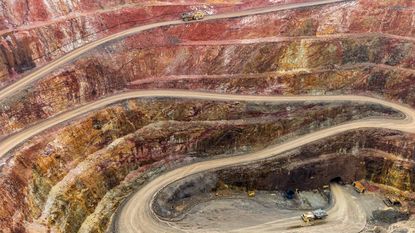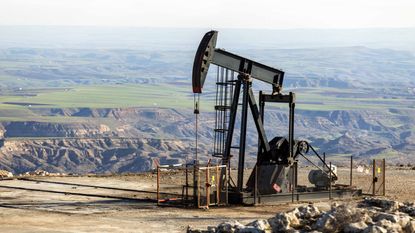5 Superb Stocks to Shield Against Stagflation
Soaring inflation and slowing economic growth have many investors seeking out stocks that will tamp down stagflation risk. Here are five top-rated names that fit the bill.


Mounting concerns about a rare economic malady have investors increasingly seeking out stocks that protect against stagflation.
Stagflation occurs when inflation rises while economic growth slows, and the U.S. last suffered from this economic malady in the 1970s to early 1980s. At the time, oil prices skyrocketed and the inflation rate reached double-digits. Meanwhile, unemployment soared to 10.8%, and the S&P 500 lost more than half its value.
Fast-forward to the present day. While unemployment is near a pre-pandemic low, U.S. inflation is rising at its fastest pace in 40 years and economic growth is expected to moderate from 2021's red-hot levels. And both of these issues were occurring before Russian forces invaded Ukraine in late February.
Now that President Vladimir Putin's army is attacking its next-door neighbor, inflation concerns are worsening. That's in part because of the invasion's effects on commodities such as Ukrainian wheat, as well as a growing number of sanctions being imposed on Russia – the third-largest oil exporter in the world, and the largest exporter of wheat.
As for U.S. economic growth? Our gross domestic product (GDP) expanded by 5.7% in 2021.
But Kiplinger economists expect GDP to expand at a slower 4.0% in 2022, while other analyst firms are looking for even less – BofA Securities is predicting 3.6% GDP growth, while Goldman Sachs recently reduced its prediction to 3.2%.
So what are the best stocks for tamping down stagflation risks? According to asset management firm Schroders, gold, which is viewed as a safe-haven asset, was the best-performing asset in the 1970s, rallying more than 22%. Other commodities, such as raw materials and energy, also outperformed, rising 15%. Thus, stocks dealing in those commodities are a great place to start.
With this in mind, here are five commodity stocks to shield against stagflation. To cull the list, we examined only top-graded stocks in the Stock News POWR Ratings universe. The stock-rating tool measures more than a hundred different factors – from analyst sentiment to valuation to balance-sheet strength – to find which names are poised to outperform the market. All of the "stagflation stocks" listed here have Buy or Strong Buy ratings.
Disclaimer
Data is as of March 6. Dividend yields are calculated by annualizing the most recent payout and dividing by the share price.

B2Gold
- Market value: $4.6 billion
- Dividend yield: 3.8%
- POWR Ratings overall rating: B (Buy)
B2Gold (BTG, $4.35) is a senior gold miner with operating mines in Mali, the Philippines and Namibia. BTG also has reserves and development projects in a variety of additional locations. The company was founded in 2007 and is headquartered in Vancouver, British Columbia.
The combination of a weak economy and high inflation leads real rates (nominal rates minus inflation) to trend lower in a stagflationary environment – as was seen in the 1970s – which is bullish for gold prices. Lower real rates make owning gold more attractive because there's less of a carrying cost, so it offers better protection against inflation.
This is what makes BTG one of the best stocks for stagflation.
What's more, in 2021, the company produced 1.0 million ounces of gold at an all-in cost of production of $888 per ounce. As such, BTG is one of the lower-cost producers and an attractive option for investors who are bullish on gold.
Next year, B2Gold is forecasting total gold production between 990,000 and 1.1 million ounces at an all-in cost of production between $1,010 per ounce and $1,050 per ounce. Currently, it is anticipating adjusted earnings per share (EPS) of 38 cents and $1.8 billion in revenue for the full year – which would be modest improvements over 2021.
BTG has an overall B (Buy) rating in the POWR Ratings system. Included in this score is a Value Grade of B, with the stock's low forward price-to-earnings (P/E) ratio of 9.6x indicating it is quite cheap.
And the company earns an A for Quality, which is consistent with its low cost of production, ownership of high-quality assets and generous dividend yield. B2Gold is a mature company given that it's expected to produce over 1 million ounces of gold for the next couple of years. It also rewards investors with a healthy 3.8% dividend yield. Check out the complete POWR Ratings for BTG, including a deeper dive into its component scores.

Vale
- Market value: $97.6 billion
- Dividend yield: 13.4%
- POWR Ratings overall rating: B (Buy)
Vale (VALE, $20.15) is the world's largest producer of iron ore, iron ore pellets and nickel. It supplies its iron ore and iron ore pellets to the steel industry. Steel demand is expected to be strong over the next decade due to increasing construction and infrastructure spending. VALE also produces manganese ore, ferroalloys, metallurgical and thermal coal and copper.
The company has a massive logistics network that integrates mines, railroads, ports and ships. This has provided an edge for the company in the iron ore market as it significantly lowers costs. VALE should also benefit from strong demand for nickel, as the metal is used in electric vehicle batteries. Plus, copper prices have also rebounded and are trading in all-time-high territory.
As one of the world's largest owners of accessible metal deposits, VALE is a solid choice among stagflation stocks, as it will likely outperform in an inflationary environment. Further, it has invested billions in its productive capacity to extract, refine and transport these metals in a safer and more sustainable manner.
In 2021, Vale had revenue of $54.5 billion and $4.47 in EPS – up 35% and a 371% year-over-year increase, respectively. Due to analysts forecasting lower iron ore prices, Vale is expected to generate $45.9 billion in revenue and $3.08 in earnings per share in 2022. However, some deceleration may already be discounted by the stock, given its low forward P/E ratio of 4.9x.
Vale is another one of the B-rated stagflation stocks in the POWR Ratings universe, translating into a Buy. A Value Grade of B is part of the stock's overall rating – and is not surprising given VALE's rock-solid balance sheet, favorable debt-to-equity ratio of 0.5x and ownership of high-quality assets. Get the full scoop on VALE's POWR Ratings scores.

Ovintiv
- Market value: $12.5 billion
- Dividend yield: 1.6%
- POWR Ratings overall rating: A (Strong Buy)
Ovintiv (OVV, $48.65) explores and produces oil and natural gas in North America. The company's core assets include prime real estate in the Permian, Eagle Ford, Montney and Duvernay resource plays. These are some of the most cost-advantaged shales in North America, allowing OVV substantial opportunities for profitable drilling at current oil prices.
As mentioned, there are some eerie similarities in terms of the current period and the last period of stagflation in the 1970s – including rising energy prices that are being exacerbated by a geopolitical crisis.
Oil also has favorable supply/demand dynamics due to underinvestment in capital expenditures over the last decade, while demand is nearly back to pre-pandemic levels. Even with higher oil prices, companies are prioritizing paying down debt and returning money to shareholders instead of ramping up production.
Therefore, investors should consider a high-quality oil producer like OVV. In 2021, the company had a stunning earnings turnaround, reporting adjusted earnings per share of $5.35, compared to its per-share loss of $9.28 in 2020.
For fiscal 2022, analysts are currently forecasting $8.73 in earnings per share on $9.1 billion in revenue, though the final figures will be dependent on the price of oil.
According to the POWR Ratings, OVV is the first of our A-rated stagflation stocks, which translates to a Strong Buy. A-rated stocks have posted an average annual performance of 31.1%, which compares favorably to the S&P 500's average annual 8% gain.
The energy stock also has strong component scores across the board, including a Value Grade of B – due in part to its forward P/E ratio of 5.4x, which is well below the S&P 500's forward P/E ratio of 18.6x. See OVV's complete POWR Ratings breakdown.

BHP Group
- Market value: $262.7 billion
- Dividend yield: 9.6%
- POWR Ratings overall rating: A (Strong Buy)
BHP Group (BHP, $73.12) is a leading and diversified miner of iron ore, copper, oil, gas and metallurgical coal. The company was created through a merger of BHP Limited and Billiton in 2001, and BHP Billiton was renamed BHP Group in 2018. The firm's major assets include Pilbara iron ore, Queensland coking coal, Escondida copper and conventional petroleum interests, principally in Australia and the Gulf of Mexico.
The company distributes its products through a global logistics chain, which includes freight and pipeline transportation. BHP sells products through direct supply agreements with customers and on international commodity exchanges. Just like VALE, BHP's infrastructure, high-quality deposits and productive capacity are ingredients for outperformance during a period of stagflation.
According to global consultants PwC, global infrastructure spending is expected to reach $9 trillion in 2025. Spending money on infrastructure is a rare issue that has bipartisan support. This should be another source of demand for commodities like iron ore and copper in addition to more secular growth factors.
Currently, BHP is off by about 30% from its 2011 high. Yet, the stock's free cash flow per share is about 49% higher over that same time frame, despite revenue being about 6% lower. This is an indication that the company has become leaner and more efficient.
Its annual dividend payment has also tripled since the stock's last peak. These developments are an indication that the underlying business is in a much better place even though the stock price is lower.
BHP is another one of the A-rated (Strong Buy) stagflation stocks in the POWR Ratings system. Included in this overall score is a Stability Grade of B, due in part to BHP Group's massive balance sheet and its exceptional management team. Both of these were integral to the company' cutting costs and streamlining operations during the poor pricing environment of the last decade.
The stock also has a Value Grade of B, thanks to its low P/E ratio of 9.7x. Take a closer look at the rest of BHP's POWR Ratings.

Nutrien
- Market value: $52.6 billion
- Dividend yield: 2.0%
- POWR Ratings overall rating: B (Buy)
Canadian-based Nutrien (NTR, $94.99) offers crop inputs, services and solutions. The company provides potash, nitrogen, phosphate and sulfate products, as well as financial solutions, crop nutrients, crop protection products, seeds and merchandise products. It operates through 2,000 retail locations in the U.S., Canada, South America and Australia.
Just like metals and energy, agricultural names are some of the best stocks for stagflation. Investors can get exposure to this sector through fertilizer stocks like NTR which have more demand and pricing power when food prices are rising. Additionally, Russia is a major supplier of fertilizer, which means the current military conflict and resulting sanctions are likely to lead to higher prices.
Even prior to this latest catalyst, NTR was in the midst of an earnings boom. In 2020, the company reported earnings of 79 cents per share, while it earned $6.23 per share in 2021. Wall Street analysts expect this trend to continue as they have a 2022 EPS forecast of $11.32 which implies 80% upside.
As such, the stock has a Growth Grade of A – part of its overall A (Strong Buy) grade in the POWR Ratings system.
The stock is also well-liked on Wall Street, as evidenced by its Sentiment Grade of A. Of the 14 analysts covering Nutrien, 10 have a Strong Buy or Buy rating and not a single one has the stock at Sell. Check out NTR's full POWR Ratings breakdown.
Get Kiplinger Today newsletter — free
Profit and prosper with the best of Kiplinger's advice on investing, taxes, retirement, personal finance and much more. Delivered daily. Enter your email in the box and click Sign Me Up.

Jaimini Desai has been a financial writer and reporter for nearly a decade. He has helped countless investors take profitable rides on some of the hottest growth trends. His previous experience includes writing for Investopedia, Seeking Alpha and MT Newswires.
He is the Chief Growth Strategist for StockNews.com and the editor of the POWR Growth and POWR Stocks Under $10 newsletters.
-
 Financial Planning: Sisters Should Be Doin' It for Themselves
Financial Planning: Sisters Should Be Doin' It for ThemselvesMore and more women are ringin' on their own financial bells (with apologies to Aretha Franklin and Eurythmics) — but that demands a robust financial plan.
By Laura Combs, CFP® Published
-
 Stock Market Today: Stocks Dragged Down by Strong Data
Stock Market Today: Stocks Dragged Down by Strong DataInvestors weigh the prospect of no more rate cuts in the current cycle.
By David Dittman Published
-
 Can Stocks Picked by Artificial Intelligence Beat the Market? 3 Stocks to Watch
Can Stocks Picked by Artificial Intelligence Beat the Market? 3 Stocks to Watchstocks An artificial intelligence stock-picking platform identifying high-potential equities has been sharp in the past. Here are three of its top stocks to watch over the next few months.
By Dan Burrows Last updated
-
 5 Stocks to Sell or Avoid Now
5 Stocks to Sell or Avoid Nowstocks to sell In a difficult market like this, weak positions can get even weaker. Wall Street analysts believe these five stocks should be near the front of your sell list.
By Dan Burrows Published
-
 Best Stocks for Rising Interest Rates
Best Stocks for Rising Interest Ratesstocks The Federal Reserve has been aggressive in its rate hiking, and there's a chance it's not done yet. Here are eight of the best stocks for rising interest rates.
By Jeff Reeves Last updated
-
 The 5 Safest Vanguard Funds to Own in a Bear Market
The 5 Safest Vanguard Funds to Own in a Bear Marketrecession The safest Vanguard funds can help prepare investors for continued market tumult, but without high fees.
By Kyle Woodley Last updated
-
 5 Best Commodity ETFs to Buy Now
5 Best Commodity ETFs to Buy NowETFs Whether you're worried about inflation or just looking for alternative asset classes, these commodity ETFs offer exposure to popular raw materials.
By Jeff Reeves Last updated
-
 The 5 Best Inflation-Proof Stocks
The 5 Best Inflation-Proof Stocksstocks Higher prices have been a major headache for investors, but these best inflation-proof stocks could help ease the impact.
By Louis Navellier Published
-
 8 Best Energy ETFs to Buy
8 Best Energy ETFs to BuyETFs Oil and gas stocks have enjoyed a solid 2024, and these energy ETFs can give investors exposure to the space.
By Kyle Woodley Last updated
-
 5 of the Best Preferred Stock ETFs for High and Stable Dividends
5 of the Best Preferred Stock ETFs for High and Stable DividendsETFs The best preferred stock ETFs allow you to reduce your risk by investing in baskets of preferred stocks.
By Kyle Woodley Last updated
